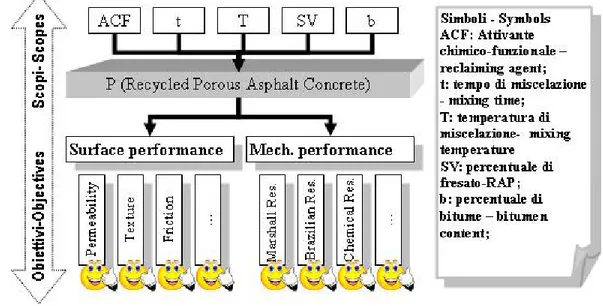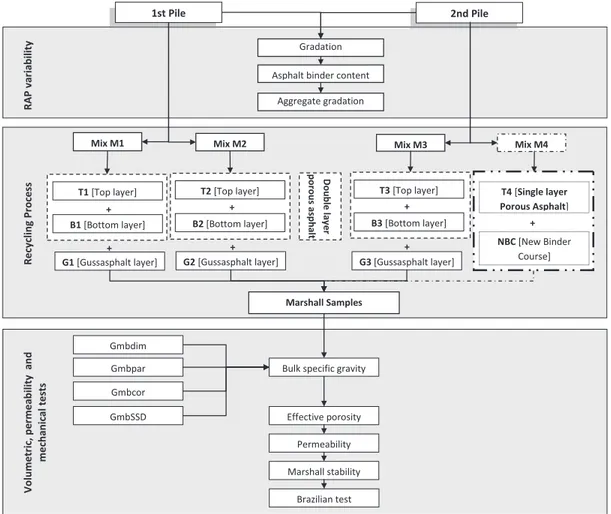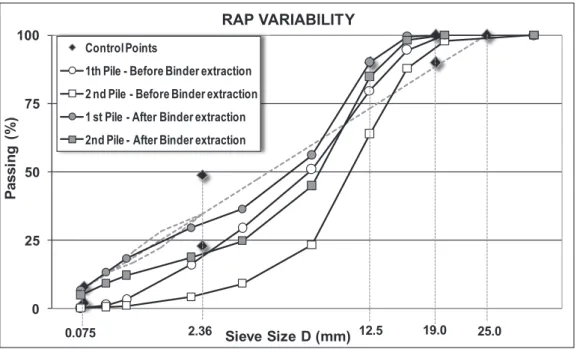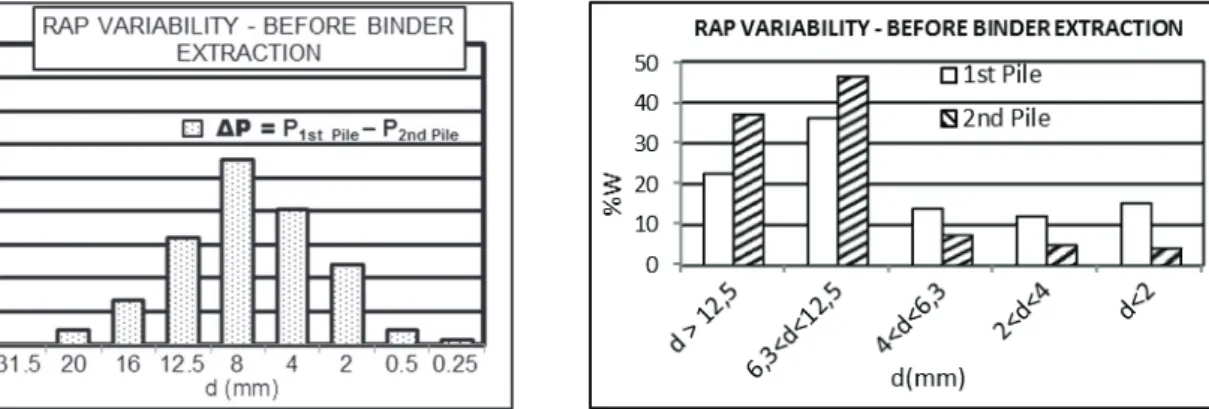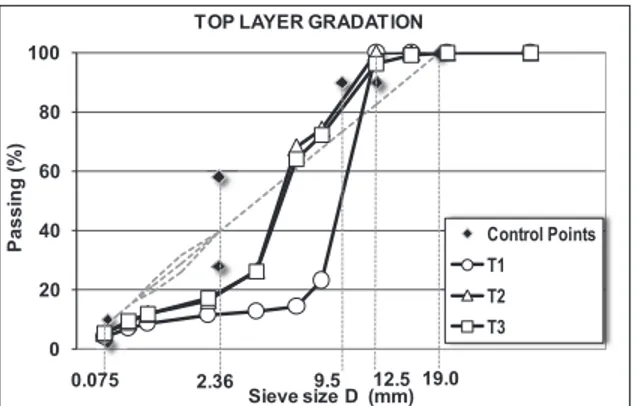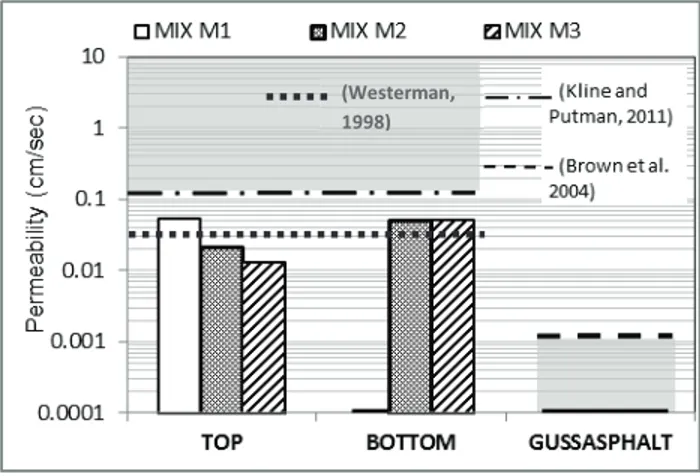Procedia - Social and Behavioral Sciences 53 ( 2012 ) 276 – 285
1877-0428 © 2012 The Authors. Published by Elsevier Ltd. Selection and/or peer-review under responsibility of SIIV2012 Scientific Committee doi: 10.1016/j.sbspro.2012.09.880
SIIV - 5th International Congress - Sustainability of Road Infrastructures
Permeable Wearing Courses by Recycling PEMs: Strategies and Technical
Procedures
Praticò F.G.
a, Vaiana R.
b*, Giunta M.
a, Moro A.
a, Iuele T.
baMediterranea University, Via Graziella, Feo di Vito, 89100 Reggio Calabria, Italy
bDep. Territorial Planning, University of Calabria, Ponte Pietro Bucci, Cubo 46b, 87036 Arcavacata Campus,Cosenza, Italy
Abstract
At the end of the lifecycle of porous European mixes (PEM) many issues arise, such as RAP (reclaimed asphalt pavement) variability and potential for high percentage recycling.
The objectives and scopes of this paper were focused into the analysis of the feasibility of a two-layer porous asphalt (TLPA) by recycling from-PEM RAP.
RAP variability was examined and a method for facing its consequences was proposed. Results are encouraging about the possibility of achieving a satisfactory level of surface performance. Practical applications and perspectives in rehabilitation, maintenance, and research are outlined.
© 2012 The Authors. Published by Elsevier Ltd.
Selection and/or peer-review under responsibility of SIIV2012 Scientific Committee Keywords: Porous European Asphalt; Reclaimed Asphalt Pavement; maintenance.
1. Introduction
The environmental sustainability of road constructions is of vital importance. In fact, natural resources (aggregates etc.) decrease while Construction and Demolition wastes (C&D) increase.
The Italian classification of waste materials is named CER (EWC, European Waste Catalogue). This classification refers to all waste materials and defines 20 categories with a number-code. Among them, the groups number 01 and 17 relate to road constructions. In particular, the group 01 comprises waste materials coming from the extraction of minerals (quarries products) while the group 17 includes all construction and demolition solid wastes (C&D), including the ones from road construction (RAP = Reclaimed Asphalt Pavement).
_________
* Corresponding author. Tel./fax: : +39 0984 496786
E-mail address: [email protected]
© 2012 The Authors. Published by Elsevier Ltd. Selection and/or peer-review under responsibility of SIIV2012 Scientific Committee
Their utilization has a great strategic importance because of their high availability and consequent reduction of quarries exploitation.
Pavement recycling philosophy has sure advantages compared to conventional pavement construction and rehabilitation [1-4]: reduction of the costs of new construction and rehabilitation projects, agreement with an environmental sustainable development in terms of conservation of energy, mineral aggregates, and bitumen binder and a reduction of the construction time delay.
Today recycling and regeneration of asphalt concretes, hot and cold technique, have a particular and increasing importance. These techniques allow to produce asphalt concretes in which the aggregate components can be a "mix" of RAP and virgin aggregates. The binding action is given by bituminous emulsion and Portland cement, in cold recycling process, and by bituminous binders and rejuvenating agents, in hot recycling.
In the International literature, RAP materials are commonly used, both in cold and hot mix asphalt procedures. Usually, scientific literature proposes recycling techniques that allow the production of dense asphalt concrete, while few studies deal specifically with the recycling of open-graded friction courses or porous European Mixes (PEMs). As is well known, these latter are open-graded surface courses with high void content (20% circa).
Two-layer porous asphalts, TLPAs, can be considered as the evolution of PEMs. They have a bottom layer with a large aggregate size gradation and a top layer having a smaller aggregate size gradation. The top layer keeps debris from clogging the lower layer. The bottom layer has a larger aggregate size gradation in order to produce larger sized air voids.
It’s important to emphasize that PEM properties vary over the time; in fact, PEM may gradually lose permeability due to dirt and debris particles filling voids.
There are two main methods of cleaning PEMs: (i) cleaning by a fire hose and (ii) cavitation of the water through the use of special nozzles. Different studies suggest that cleaning techniques should begin while the layer is still permeable. By starting while the layer is still permeable, regular maintenance should maintain permeability of the layer for a longer time period, [5].
Although pavement recycling is a spreading technique, several concerns need to be well addressed when RAP materials are used in new constructions, such as RAP variability and impact of RAP on traditional (bearing properties, skid resistance) and premium (silentness, drainagebility) performance, [6].
[7-9] studied mechanical properties and functional performance of a two-layer porous asphalt derived from the reclaimed asphalt pavement, used in a percentage of around 80%. They found that mechanical performance was adequate, functional performance resulted very promising and also environmental compatibility was achieved.
It is noted that when the material comes from old porous asphalt layer there are some specific questions to consider [10]: (i) the penetration of the binder in the old material can be very low and as a consequence there could be problems regarding blending such a hard bitumen with the new binder; (ii) if a modified binder is used in the old porous asphalt there could be compatibility issues about the use of the modified binder with the newly added binder; (iii) it is important to consider the pollution related to the old porous asphalt which can consist of an accumulation of organic as well as inorganic materials (such a heavy metal).
Among the factors which can affect RAP variability the following can be cited : (i) the inhomogeneity of the bituminous mixture, in terms of gradation and binder content, due to construction, maintenance and repair processes during the life-cycle (patches, chip seals, other maintenance treatments, geogrids or geotextiles); (ii) the variability related to the milling process, to the stockpile, to the handling and the transportation.
In order to mitigate RAP variability, attention has to focus on road markings, coal tar and soil contained in the RAP, and other sources of inhomogeneity such as crack seals and patches.
In contrast, in the case of low variability of RAP, it is possible to improve aggregate gradation, binder content and stiffness, through an appropriate proportion of virgin material added, [11].
The quality of the recycled mixture can be easily controlled by using less than 25% RAP. On the other hand, in recent years the percentages of RAP in hot and cold recycling and in production of new asphalt mixture is increasing.
As a consequence, when higher percentages are used, a thorough homogenization of the RAP is usually required [12-13].
2. Aims and objectives
In the light of the abovementioned facts the authors of this paper are running the research project of Italian national interest (PRIN 2008) “Drenante Da Drenante”.
The main goal of this research is confined to the recycling of Reclaimed Porous European Mixes back into new porous pavements, such as PEMs and TLPAs.
Attention is focused on the maximization of RAP percentage through RAP pre-processing, by operating on asphalt binder (processes included), and, in particular, by adjusting the mix of the new bitumen, the old one (polymer modified) and the reclaiming agent.
The following targets were stated in the original project, see Figure 1:
assessing a better knowledge of the role of reclaiming agent in recycling processes of porous asphalt on the basis of the true mechanical performance of the obtained final product;
assessing a better knowledge of mixing temperature & time role;
assessing a better knowledge on surface and hydraulic properties of the recycled porous asphalt.
Fig. 1. Objectives and scopes of 2008 PRIN project “Drenante da Drenante”
This paper focuses on the feasibility of a two-layer porous asphalt (TLPA) in addition to a waterproofing-layer by recycling RAP- from-PEM. RAP variability is examined and a method for facing its consequences is proposed.
3. Experiments and results
3.1. Experimental Plan
In order to investigate on the feasibility of a two-layer porous asphalt (TLPA) in addition to a waterproofing-layer by recycling RAP-from-PEM, the experimental plan shown in Figure 2 was designed and carried out.
The main phases of experiments were:
the analysis of RAP variability in terms of gradation before and after binder extraction; the production of 9 recycled mixes (3 Top layers + 3 Bottom layers + 3 Gussasphalt layers); the analysis of the properties of the recycled mixes.
It is noted that another phase was scheduled, which will deal with the design of a new double layer (Mix M4) characterized from a porous asphalt layer (Top layer) and a binder course (Bottom layer) by recycling RAP-from-PEM, see Figure 2.
1st Pile Mix M1 Mix M2 2nd Pile Mix M3 T1 [Top layer] B1 [Bottom layer] + T2 [Top layer] B2[Bottom layer] + T3 [Top layer] B3 [Bottom layer] + Doubl e l ay er por o us asphal t G1 [Gussasphalt layer] + G2 [Gussasphalt layer] + G3[Gussasphalt layer] + Marshall Samples Gradation Asphalt binder content
Aggregate gradation R A P va ria b ility Recycling Process Volum etri c, pe rm ea bilit y a nd mechanical tests
Bulk specific gravity
Effective porosity Permeability Marshall stability Brazilian test Gmbdim Gmbpar Gmbcor GmbSSD T4 [Single layer Porous Asphalt] Mix M4 NBC [New Binder Course] +
Fig. 2. Experimental plan. Legend. Gmb: bulk specific gravity. FILM = Parafilm method (ASTM D 1188); COR = Vacuum sealing method (ASTM D6752/ AASHTO T 331); SSD = Saturated Surface Dry method (AASHTO T 166/ ASTM D 2726 /EN
3.2. Rap Gradation and composition
Two RAP piles were analyzed in terms of gradation before and after carrying out the tests for binder extraction and asphalt binder content (according to standards UNI EN 933–1 and UNI EN 12697-1).
Although the reclaimed material was derived from the cold milling of the same porous asphalt pavement, RAP management practices and its intrinsic heterogeneity determined RAP variability (see Figs 3-7).
Figure 3 compares the RAP gradations (before and after binder extraction) with the SHRP Specifications for a 19 mm-Nominal Maximum Aggregate Size (NMAS, one sieve size larger than the first sieve to retain more than 10 percent). The 0.45 power gradation chart is used. Maximum density gradation (dotted straight line from the maximum aggregate size through the origin), control points (master ranges through which dense-graded gradations must pass), and restricted zone (RZ, band through which gradations should not pass) are shown. Note that many authors do not agree with RZ inclusion in Superpave and that gradation control points and the restricted zone apply to dense-graded mixtures and not to porous asphalt concretes.
0 25 50 75 100 Pa ss in g ( % ) Sieve Size D (mm) RAP VARIABILITY Control Points
1th Pile - Before Binder extraction 2 nd Pile - Before Binder extraction 1 st Pile - After Binder extraction 2nd Pile - After Binder extraction
0.075 2.36 12.5 19.0 25.0
Fig. 3. RAP gradations before and after binder extraction (19 mm-NMAS)
Figure 4 refers to RAP variability before binder extraction. The difference (ΔP) in percentage passing the given sieve is reported as a function of the sieve opening (d, mm). ΔP values were calculated by subtracting the percentages of RAP passing each sieve for the second RAP pile from the percentages passing the same sieves for the first RAP pile.
Note that ΔP values ranged from 0% (31mm-sieve) to 27 % (8mm-sieve). The reclaimed material was separated into several fractions before mixing.
Figure 5 illustrates the variability of percent content, %W (w/w), of different RAP fractions in the two abovementioned cases (1st and 2nd pile).
Fig. 4. RAP variability: difference of percent passing Fig. 5. RAP variability: percent content of fractions
ΔP variability was also analyzed in terms of percentage of recovered asphalt binder for the different RAP fractions in the two examined cases (Figs 6 and 7).
Pb or Pm indicate the asphalt binder content by weight of aggregate or mix, respectively.
Fig. 6. RAP variability: asphalt binder content by weight of aggregate Fig. 7. RAP variability: asphalt binder content by weight of mix
3.3. Recycling Process
Figure 8 illustrates the RAP percentages used in recycling. Overall, around the 97% of RAP from PEM was used in each trial. Mixes were compacted at a temperature of 170°C. Rejuvenating agents were added to the mix in order to improve recovered binder performance, [14]. As it is possible to see in the graphs of figure 8, the amount of RAP used in the production of the three mixes (M1, M2 and M3) is higher than 95%. Very few percentages of recycled material were not used. This is consistent with the main objective of the project PRIN 2008 “Drenante Da Drenante” that consists in the possibility of recycling the maximum amount RAP-from-PEM with the lowest environmental impact (for example, due to the use of virgin aggregate).
Fig. 8. RAP percentages Figures 9 to 11 show the gradations of the recycled mixes.
0 20 40 60 80 100 P a s s ing ( % ) Sieve size D (mm) TOP LAYER GRADATION
Control Points T1 T2 T3 9.5 12.5 0.075 2.36 19.0 0 20 40 60 80 100 P a ssi n g (% ) Sieve Size D (mm) BOTTOM LAYER GRADATION
Control Points B1 B2 B3 25.0 0.075 2.36 12.5 19.0
Fig. 9. Recycled mixes gradations – Top Layer (12.5 mm-NMAS) Fig. 10. Recycled mixes gradations – Bottom layer (19 mm-NMAS) 0 20 40 60 80 100 Pa s s in g (% ) Sieve Size D (mm) GUSSASPHALT GRADATION Control Points G1 G2 G3 0.075 2.36 4.75 9.5 12.5
3.4. Functional and mechanical performance
The functional performance of recycled mixes was analyzed in terms of volumetrics and permeability (ASTM PS 129), [15-16].
For the mixes produced with the first pile of RAP, the air void content of the bottom layer ranged from about 10% (mix M1) to 19% (mix M2), see figure 10. The air void content for the bottom layer produced in the third trial reached an higher value (21%).
Top layers resulted satisfactory in each trial: the air void content was quite high (around 22%) for T1 mix and it resulted acceptable also in the second and third trial in which it was close to 16%.
Gussasphalt layers resulted in an air void content always lower than 3%.
As for permeability, in the second trial the bottom layer showed a higher permeability in comparison with the first trial in which the permeability was quite negligible, see figure 12. Note that the mix M1-TOP in Figure 12 corresponds to the gradation T1 shown in Figure 9, while M1-BOTTOM in Fig.12 corresponds to B1 in Fig.10, where an excess of aggregates in the size range 2/6 mm was observed.
Furthermore, in Figure 12, two types of threshold were reported: i) minimum permeability for Open-Graded Friction Courses, [17-18]; ii) maximum permeability for dense mixes, [19].
(Westerman, 1998)
Fig. 12. Permeability of recycled mixes (ASTM PS 129)
As it is possible to observe in figure 12, the values of permeability of several TOP and BOTTOM mixes are close to the thresholds. However, these results seem to be quite satisfactory since the main “boundary condition” for the production of the recycled mixes was the use of around 100% of RAP-from-PEM. Moreover, the study conducted by Westerman [18] shows that asphalt mixes characterized by a permeability rate varying in the range 10-1-10-4 cm/sec (mean value of 0.03cm/sec) can be classified as “high permeability” mixes. According to this
classification, as it is possible to see in figure 12, both the top and the bottom layer permeability results adequate. The mechanical properties of the recycled mixes were examined in terms of Marshall stability (UNI EN 12697-34) and Brazilian test (UNI EN 12697-23). Figures 13 and 14 refer to mechanical performance and show the thresholds (dotted lines) according to the Italian standard specification for Top and Bottom layers, [20]. For the mixes under examination the Marshall stability resulted satisfactory.
0,0 5,0 10,0 15,0 20,0 25,0 30,0
TOP BOTTOM GUSSASPHALT
M ar sh all S ta bili ty (K N ) 303030303030,000000
MIX M1 MIX M2 MIX M3
Minimum value for Top and Bottom Layers
0,0 0,3 0,6 0,9 1,2 1,5 1,8 2,1 2,4
TOP BOTTOM GUSSASPHALT
T e ns ile S tr e ng th ( N /m m 2)
MIX M1 MIX M2 MIX M3
Minimum and Maximum values for Top and Bottom Layers
Fig. 13. Mechanical performance: Marshall stability Fig. 14. Mechanical performance: Tensile Strength
4. Conclusions
Many issues can arise for PEMs at the end of their lifecycle: RAP variability, uncertainties on the potential for high percentage recycling, issues pertaining the potential for recycling a surface layer back to a surface layer.
Based on the abovementioned facts, objectives and scopes were then focused into the analysis of the feasibility of a two-layer porous asphalt (TLPA) by recycling from-PEM RAP, when highly variable rap stockpiles are involved.
This project was run under the auspices of the research project of national interest, PRIN 2008, Research Project “Drenante da Drenante”.
The following main issues were addressed: preserving traditional (bearing properties, skid resistance) and premium (silentness, drainagebility) performance; recycling high percentages of from-PEM RAP. Materials selection was followed by mixtures production. Traditional and advanced tests on RAP and recycled mixes were carried out.
RAP variability was examined and a method for facing its consequences was proposed. Mechanical performance was adequate and environmental compatibility was achieved. Functional performance resulted very promising. The aggregate gradation of the bottom layer in the size range 2/6 mm resulted very relevant. Results are encouraging about the possibility of achieving a satisfactory level of surface performance.
Practical applications and perspectives in rehabilitation, maintenance, and research were outlined. Future research will aim at gaining a better understanding of the investigated relationships. Outcomes of this study are expected to benefit both practitioners and researchers.
References
[1] Kandhal, P. S., & Mallick, R. B. (1997). Pavement Recycling Guidelines for State and Local Governments Participant's Reference Book. National Center for Asphalt Technology, Publication No. FHWA-SA-98-042. Available on the Internet: http://www.fhwa.dot.gov/pavement /recycling/98042/.
[2] Torbjörn, J. (2002). Cold Recycling Of Asphalt Pavement - Mix In Plant. Swedish National Road and Transport Research Institute, Sweden, 2002.
[3] Suresha, S. N., Varghese, G., & Ravi Shankar, (2010). Properties of cellulose fibres and waste plastic modified porous friction course mixes. Baltic Journal of Road and Bridge Engineering 5 (3), 156-163.
[4] Alvarez, A. E., Fernandez, E. M., Epps Martin, A., Reyes, O. J., Simate, G. S., & Walubita, L.F., (2012). Comparison of permeable friction course mixtures fabricated using asphalt rubber and performance-grade asphalt binders. Construction and buolding materials, DOI: 10.1016/j.conbuildmat.2011.08.085, Volume 28, Issue 1, March 2012, 427-436.
[5] Cooley, L. A., Brumfield, J. W., Mallick, R. B., Mogawer, W. S., Partl, M., Poulikakos L., & Hicks, G. (2009). Construction and Maintenance Practices for Permeable Friction Courses. NCHRP REPORT 640, TRB, ISBN 978-0-309-11796-8.
[6] Boscaino, G., & Pratico, F. G. (2001). A classification of surface texture indices of pavement surfaces | [Classification et inventaire des indicateurs de la texture superficielle des revêtements des chaussées]. Bulletin des Laboratoires des Ponts et Chaussees (234), pp. 17-34+123+125+127.
[7] Praticò, F. G., Vaiana R. & Giunta, M. (2011). Recycling PEMs back to innovative, silent, permeable road surfaces. Proceedings of the 8th International Conference on Environmental Engineering May 19–20, 2011, Vilnius, Lithuania. ISSN 2029-7092 online.
[8] Praticò F. G., Vaiana R., & Giunta M., (2012). Sustainable rehabilitation of porous European mixes. Proceedings of the ICSDC 2011 ASCE - Integrating Sustainability Practices in the Construction Industry, pp. 535-541. DOI: 10.1061/41204(426)66.
[9] Praticò F. G., & Vaiana R., (2012). Improving infrastructure sustainability in suburban and urban areas: is Porous asphalt the right answer? And how?. 18th International Conference on Urban Transport and the Environment, 15 - 17 May, 2012, A Coruña, Spain. DOI: 10.2495/UT120571
[10] Nilsson, R., Nordlander J-O, & Sliwa, N. (2005). Design guidelines for durable, noise-reducing pavements. SILVIA Project Report SILVIA-SKANSKA-018-01-WP4-231105.
[11] Karlsson, R., & Isacsson, U. (2006). Material-related aspects of asphalt recycling – State-of-the-art. Journal of Materials in Civil Engineering 18(1): 81–92. DOI: 10.1061/(ASCE) 0899-1561(2006)18:1(81).
[12] Perez, F., Rodriguez, M., De Visscher, J., Vanelstraete, A., & De Bock, L. (2004). Design and performance of hot mix asphalts with high percentages of reclaimed asphalt: approach followed in the paramix project. Proceeding 3rd Eurasphalt&Eurobitume Congress, Vienna 2004, 447-459.
[13] Saeed, A. (2001). Performance-Related Tests of Recycled Aggregates for use in Aggregates for Use in Unbound Pavement Layers. NCHRP Report 598, Transportation Research Board, National Research Council. Washington, DC (2001) 55.
[14] Praticò, F. G. (2004). A theoretical and experimental Study of the effects on mixes added with RAP caused by Superpave restricted zone violation. Journal of Road Materials and Pavement Design, vol. 5, no1, 73-91.
[15] Pratico’ F. G., Moro A., & Ammendola R., (2009). Modelling HMA Bulk Specific Gravities: a Theoretical and Experimental
Investigation. International Journal of Pavement Research and Technology, 2(3):115-122- May 2009- ISSN: 1997-1400 (on-line) 1996-6814 (print).
[16] Praticò F. G., & Moro A., (2007). Permeability and volumetrics of porous asphalt concrete: a theoretical and experimental investigation. Road Materials and Pavement Design, VOL 8/4 – 2007.
[17] Kline, L. C., & Putman, B. J., (2011). Comparison of Open Graded Friction Course (OGFC) Mix Design procedures in the United States. Transportation Research Board, Annual Meeting, Washington (USA) 2011.
[18] Westerman, J. R. (1998). AHTD’s Experience with Superpave Pavement Permeability. Presented at Arkansas Superpave Symposium, January 21, 1998.
[19] Brown E. R., Hainin, M. R., Cooley, A., & Hurley, G. (2004). Relationship of Air Voids, Lift Thickness, and Permeability in Hot Mix Asphalt Pavements. National Cooperative Highway Research Program, NCHRP REPORT 531, 2004.
